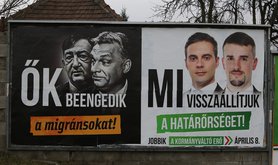
A century after the Trianon Treaty: perceptions of Hungary in Serbia and Croatia
For a decade, Viktor Orbán has shifted the lens of the Hungarian government’s grievances from the neighbouring states and minority issues towards Brussels.

The Trianon Treaty (June 4, 1920), its legacies, symbolism and interpretations, still divides countries and societies across the Carpathian basin. In Hungary, this anniversary remains largely intertwined, in both political and public discourse, with imageries of national dismemberment and historical injustice.
By contrast, in neighbouring Slovakia and Romania, the signing of the Trianon Treaty is associated with the acquisition of independent statehood and the liberation of the regions of Transylvania and the Banat, respectively. In addition to the aforementioned states, Serbia and Croatia also comprise former territories of the old Hungarian kingdom where ethnic Hungarian populations reside up to date. This piece provides a brief overview of perceptions of Hungary in Serbia and Croatia, as well as the situation of the ethnic Hungarian minorities in each state, a hundred years after the signing of the Treaty.
Serbian perceptions of Hungary
According to the national census of 2011, around 251,136 ethnic Hungarians resided in the Serbian autonomous province of Vojvodina (13% of the local population). The Alliance of Hungarians in Vojvodina/VMSZ is the largest party that claims to represent ethnic Hungarian interests and has participated in several coalition governments in Serbia since 2000. Although a richly diverse and multi-ethnic region, Vojvodina succeeded in withstanding interethnic friction to a remarkable degree during the outbreak of violent conflicts across the former Yugoslavia in the 1990s. Moreover, an extensive legal framework safeguards the collective rights of ethnic Hungarians and other minority groups on the provincial and the republican levels of authority.
Nevertheless, this is not to say that relations between Serbs and ethnic Hungarians have lacked occasional friction. Between 2003 and 2005, a spate of incidences often categorized as ‘ethnic’ took place in Vojvodina. These incidences ranged from hate graffiti to acts of vandalism directed against churches or graveyards – as well as the forceful removal of public signposting in the Hungarian language. In most cases, however, they involved violent clashes between individuals or groups of youths belonging to different ethnic affiliations (most commonly, Serbs and ethnic Hungarians or Croats). Throughout that period, a series of Hungarian governments accused Serbian authorities of indifference at the Council of Europe and other international forums. This friction resulted in the temporary deterioration of Serbian-Hungarian relations.
We’ve got a newsletter for everyone
Whatever you’re interested in, there’s a free openDemocracy newsletter for you.
Between 2014 and 2016, the attempts by Jobbik-affiliates to open offices for the party, first in Subotica and later in Senta (northern Bačka), created another potential source of tension –given the nationalist and irredentist prerogatives espoused by Jobbik. However, these endeavours were repeatedly thwarted by the local authorities. Serbian legislation prohibits the operation of political parties and organizations which serve foreign interests in the territory of Serbia. More importantly, as early as January 2014, the VMSZ chairman, István Pásztor, warned Jobbik, on the occasion of the party’s attempt to inaugurate its Subotica office, that ‘we do not need anyone, not a single one, who comes from Hungary to ignite fire with their irresponsible behaviour, and then go home’ and added that ‘Vojvodina’s Hungarians have never been and will never become protagonists in either Serbian or Hungarian nationalism’.
The chairman of VMSZ is said to have been the politician who played a pivotal role in the latest rapprochement between Serbian President Aleksandar Vučić and Hungarian PM Viktor Orbán – the first foreign leader to have congratulated Vučić on the occasion of his party’s (Serbian Progressive Party/SNS) victory in the latest parliamentary elections (June 21, 2020). The Hungarian government’s decision to erect a razor-wire fence along the borderline with Serbia, during the outbreak of the refugee crisis (summer-autumn 2015), triggered another temporary friction between the two sides. Nevertheless, the rapprochement between the two leaders has resulted in the considerable improvement of bilateral relations between Serbia and Hungary. Both statesmen seem to share a series of common traits with respect to their patterns of personal leadership and governance of the state. However, Aleksandar Vučić and Viktor Orbán have also been accused of being primarily inclined towards serving their, short-term, private interests instead of aiming at resolving any outstanding historical differences and achieving a genuine and long-lasting reconciliation between the two nations.
The rapprochement between the two leaders has resulted in the considerable improvement of bilateral relations between Serbia and Hungary.
The economic transactions between the two states remain steady and the Serbian exports to Hungary intensified during the period between 2015 and 2020. Moreover, Budapest remains one of the most popular tourist destinations among Serbian citizens whereas the number of Hungarian tourists who visit Novi Sad, other parts of Vojvodina and Belgrade has increased over the last few years.
A string of public surveys, conducted between 2016 and 2019, hint at a state of harmonious cohabitation between Serbs and ethnic Hungarians in Vojvodina. The same surveys also found out that the majority of the (Serbian) respondents regarded Hungary as one of Serbia’s friendliest neighbours.
Croatian perspectives on Hungary
According to the national census of 2011, around 14,048 ethnic Hungarians resided in Croatia (0.33% of the total population). The ethnic Hungarian community is concentrated in the regions of (mostly eastern) Slavonia, Baranja, Srijem, Istria, parts of Zagorje and the capital city of Zagreb. The Constitutional Law on the Rights of National Minorities/CLRNM (2002) dictates the ‘fixed’ reservation of one seat for the proportional representation of the ethnic Hungarian minority at the Croatian national assembly (Sabor) in Zagreb. Elsewhere, the same document provides for proportional representation at the municipal and local bodies of authority in these districts where the ethnic Hungarian presence is particularly dense.
The significantly smaller size of the ethnic Hungarian community in Croatia, in comparison to their co-ethnics in Serbia, and the absence of organized political structures within this minority group effectively prevented the emergence of tensions over its collective status between Croatia and Hungary – throughout the span of independent Croatian statehood. To these one might add the historical legacies from the operation of Croatia-Slavonia as a sub-kingdom inside the old Hungarian realm and the state of relative autonomy enjoyed by the Croatian council of nobles (the ‘Croatian Diet’).
Croatia is currently governed by the (nominally, conservative centre-right) Croatian Democratic Union/HDZ. The chairman and Croatian PM, Andrej Plenković, has shifted the official party-narrative more firmly towards the centre. Nevertheless, HDZ also comprises a non-negligible ‘right-wing faction’ that harbours more socially conservative outlooks on policy-areas such as: minority issues; LGBTQI rights, abortion, and other gender-related themes; relations between Church and state; the management of the migration crisis; and law and order. Along the lines of their shared system of values and preferred patterns of policymaking over the aforementioned areas, the representatives of HDZ’s ‘right-wing faction’, in particular, have frequently expressed their appreciation for Viktor Orbán. Some of these HDZ-affiliates maintain steady links to conservative think-tanks and NGOs based in Hungary whereas others have contended that Croatia must become the ‘fifth Visegrad state’.
The chairman and Croatian PM, Andrej Plenković, has shifted the official party-narrative more firmly towards the centre.
This is not to say, though, that no occasional tensions have been witnessed. As in Serbia, the Hungarian government’s decision to set up the razor-wire fence along the southern borderline was also met with disapproval by the majority of the deputies at the Sabor. Most recently, in May 2020, Viktor Orbán’s decision to upload a post on his Facebook page, featuring a map of the old Hungarian kingdom, caused a wave of discontent in Croatia. Andrej Plenković opted for a calm approach by stating that ‘the current Croatian borders are as they are’ and pledged to discuss this misunderstanding in greater detail with his Hungarian counterparts. Croatian President Zoran Milanović, nominated by the Social Democratic Party/SDP, assumed a more critical stance and advised against the public display of similar ‘greater’ Croatian maps because ‘such actions can only irritate one country’s neighbours’.
Otherwise, the economic transactions between the two sides are stable and the Croatian exports to Hungary between 2015 and 2020 have also increased. The Dalmatian coast, Istria, Rijeka and Zagreb remain among the most popular tourist destinations for Hungarians whereas many Croats visit Budapest and other Hungarian towns or places of interest in the vicinity (e.g. Pécs and the Lake Balaton area).
Rapprochement
Both Serbia and Croatia comprise former territories of the old Hungarian kingdom as well as ethnic Hungarian populations inside their boundaries. Nevertheless, the last decade has witnessed the considerable upgrading of Hungary’s bilateral relations with these two adjacent states as well as the improvement of Hungary’s image in Croatian and Serbian societies. This is of particular significance in the case of Serbia – always taking into account the frequently strained bilateral relations between the two countries over the collective rights of the ethnic Hungarian minority in Vojvodina during the 1990s.
The consolidation of political parties with a conservative right-wing agenda in all three countries (FIDESZ, SNS and HDZ) additionally facilitated the rapprochement among their respective leaderships and the subsequent normalization of inter-state relations. To this should be added the fact that, for a decade, Viktor Orbán has largely shifted the lens of the Hungarian government’s grievances from the neighbouring states and minority issues towards Brussels (e.g. disagreements and controversies over the rule of law in Hungary and the ‘quota arrangement’ for the redistribution of refugees within the EU-space).
Read more
Get our weekly email




Comments
We encourage anyone to comment, please consult the oD commenting guidelines if you have any questions.